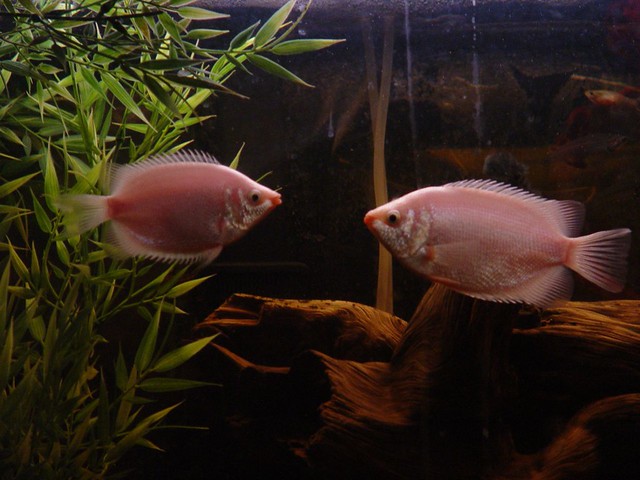Kissing Gourami or Helostoma temminckii, are members of the familyHelostoma. Kissing gouramies inhabit the heavily vegetated, shallow, slow-moving backwaters prominent in Thailand and Indonesia. Most of the fish exported for the freshwater aquarium trade industry are commercially raised on fish farms throughout Southeast Asia.
 |
| Kissing Gouramis - Photo by Clevergrrl (cc) |
Kissing gouramis are one of the largest gouramies kept in freshwater aquariums. They will reach an adult length of anywhere between 7.5-12 inches even in the confines of an aquarium. These fish have laterally compressed, slightly rounded bodies. Their caudal fins are either rounded or concaved. Their most prominent feature is their mouths which protrude out characteristically outward from their face. Their lips are lined with horney teeth. Their jaw assemblies lack teeth. Kissing gouramies are commercially available in two colors. The one most commonly found in home aquariums are white.
White gouramies have a pearlescent sheen to their bodies with a pink or orangish tinge and transparent pinkish fins. There is also a dwarf variety available. Dwarf kissing gouramies are a mutated strain of pink gourami. They are frequently referred to as balloon gouramies because of their smaller more rounded bodies.
The kissing gouramies for a sale at the local fish store are quite young. Juveniles grow rapidly and will quickly outgrow a small aquarium. An adult kissing gourami requires a minimum tank size of 50 gallons. You will need a larger aquarium for a well-populated community tank. These fish have semi-aggressive temperaments. They generally mix well with fish of similar size and attitude. But they are prone to bully smaller, more timid tank mates. They are generally tolerant of conspecifics but males frequently challenge each other for dormancy. Said challenge consists of locking lips and engaging in a shoving match much like a deer will lock horns and attempt to force its challenger into submission. Kissing gouramies have a habit of enjoying digging in aquarium substrate. The best way to minimize this is by using larger, coarser gravel and larger rather than smaller rocks in your aquarium.
This is an omnivorous species. Algae make up a significant part of their diet. They are extremely efficient tank cleaners. It is recommended that you do not clean your aquarium glass during routine tank cleaning. These gouramies will use their toothed lips to scrape algae off the surfaces of your aquarium. This form of algae removal is commonly perceived as kissing. They will instinctively graze on most aquarium plants. Ineatable plants such as java moss and java fern work well with kissing gouramies. Aside from these, plastic plants are highly recommended. Algae pellets in addition to a good quality flake food make an excellent staple. They will also readily accept frozen and freeze-dried food products. Brine shrimp and tubifex make wonderful protein supplements. Kissing gouramies have an affinity toward blanched table vegetables. Lettuce leaves are an all-time favorite. Regular portions of vegetables will finish providing a well-balanced diet.
This fish thrives in water temperatures between 72-82 °F. They function fine in pH levels that vary slightly on either side of a neutral balance; 6.8-8.5. With proper care, a kissing gourami should live between 5-7years of age.
Breeding Kissing Gouramies
Kissing gouramies are sexually dimorphic. Males and females are virtually identical with the exception that females tend to be a little larger and have a slightly fuller body than males.
Proper diet and aquarium conditions will help induce the breeding cycle. A protein-rich live diet such as brine shrimp will help precondition your gouramies for spawning. Raising the water temperature up to 80 °F properly simulates the breeding season. Gouramies are more apt to breed in soft water conditions.
The breeding process is typically initiated by the female and takes place under the cover of floating vegetation. Lettuce leaves provide the necessary camouflage to perpetuate breeding. The breeding ritual begins by the couple circling each other. This quickly escalates to nudging each other, dancing and concludes with a frantic tail beating. Breeding commences when the male warps his body around the female and turns her upside down. The female will then release several hundred eggs. The male fertilizes the eggs as they rise to the surface. Gourami eggs are buoyant and will float.
Kissing gouramies are open-water egg scatterers. Unlike many gouramies, these fish do not build a bubble nest for their future offspring. Nor will they guard their eggs. Once spawning has occurred, the adults should be removed from the breeding tank to avoid predation. The same lettuce leaves that provided a suitable environment for spawning will now function as a breeding chamber of sorts. Gourami eggs will adhere to the lettuce. The eggs will hatch in approximately 24 hours. The lettuce provides a natural source of infusoria for the newly hatched fry. Fry will be free swimming in about two days. Free swimming fry can be fed finely crushed flake food or baby brine shrimp.
The hottest new trend in aquarium ownership is pet jellyfish. Jellyfish require a specially designed Jellyfish Aquarium Fish Tank to remain alive and healthy. Jellyfish aquariums are easier to maintain than a traditional saltwater tank. Pet Moon Jellyfish have become exceptionally popular in recent years with home aquarists both for their unparalleled elegance and ease of care. The market for moon jellies has increased to the point that two US-based websites are now tank raising these exotic creatures to keep pace with the growing demand.
|

No comments:
Post a Comment